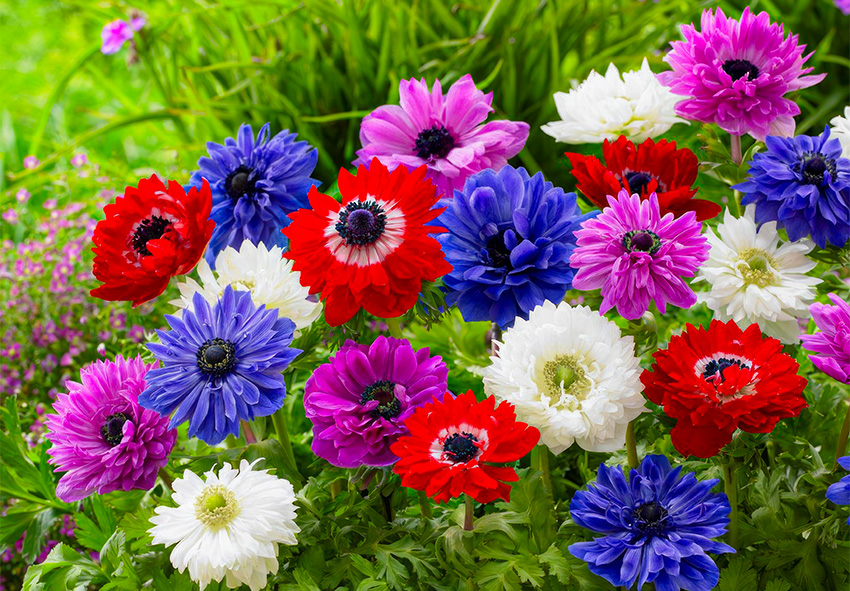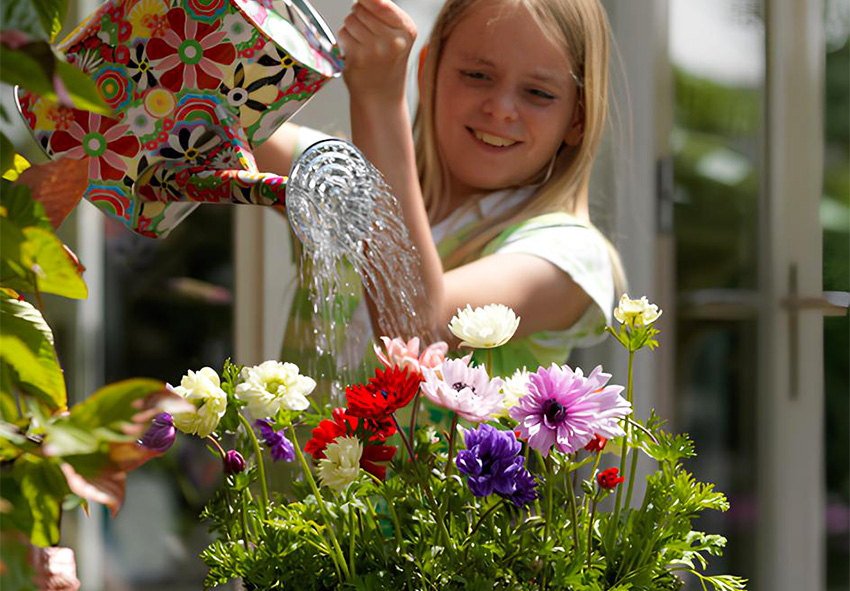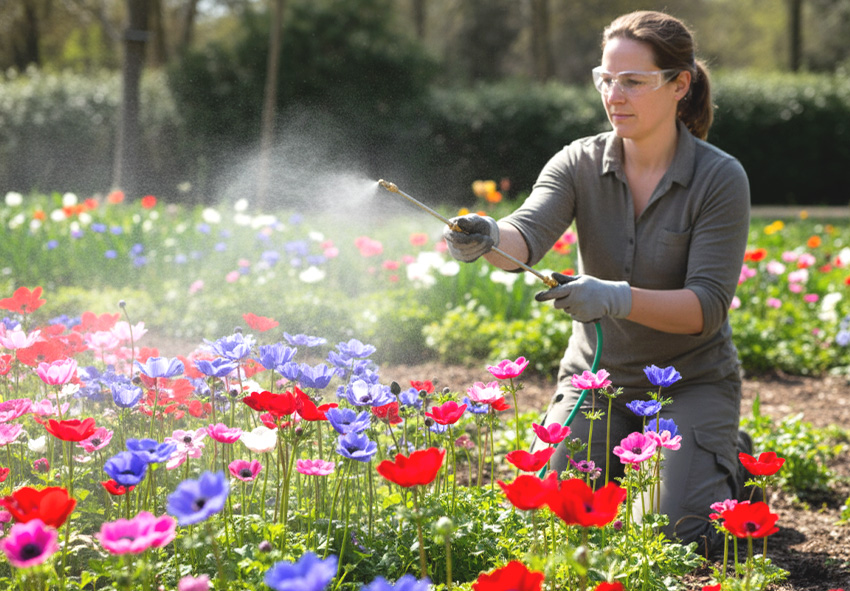Anemones are among the most charming spring and fall bloomers, offering delicate flowers in a wide range of colors. However, like many ornamental plants, they are vulnerable to pests and diseases that can weaken growth and spoil their beauty. If you want to enjoy healthy, thriving plants, learning about anemone pest control is essential. This guide will walk you through the most common problems, natural remedies, and preventive steps to keep your garden flourishing. Our gardening blog is a perfect place to find all the information you need!
Why Pest Control is Important for Anemones

Pests and diseases don’t just damage the leaves or flowers of anemones — they weaken the plant’s overall structure. When left unchecked, infestations can reduce blooming, stunt growth, and sometimes kill the plant. Even a minor pest problem can quickly spread if ignored. By understanding the threats and responding early, you can ensure your anemones remain resilient and beautiful throughout the season.
Common Pests Affecting Anemones
Several types of insects feed on anemones. Some target the leaves, while others damage roots or flowers. Identifying pests early is key to preventing lasting damage.
Aphids
Aphids are small, soft-bodied insects that cluster on young stems and flower buds. They suck out plant sap, leaving behind distorted leaves and weakened flowers. In addition, aphids secrete honeydew, a sticky substance that attracts ants and encourages sooty mold growth. A strong blast of water or natural sprays can help manage them.
Slugs and Snails
These slimy pests are notorious for chewing irregular holes in leaves and petals. They are especially active at night or during rainy weather. Slugs and snails can quickly strip foliage from anemones if not controlled. Barriers such as copper tape, crushed eggshells, or organic slug pellets provide effective protection.
Spider Mites
Spider mites thrive in hot, dry conditions and can be difficult to spot at first. They suck plant juices, causing stippled leaves and eventual yellowing. Fine webbing between leaves is often a telltale sign of an infestation. Regular misting and neem oil sprays help discourage these pests.
Thrips
Thrips are tiny insects that feed on flowers and leaves, causing streaked or discolored petals. Heavy infestations may lead to deformed flowers and reduced flowering. Blue sticky traps and insecticidal soaps are effective ways to manage them.
Leaf Miners
Leaf miners burrow into anemone leaves, leaving winding white trails. While damage is mostly cosmetic, heavy infestations weaken the plant. Removing affected leaves and encouraging beneficial insects, such as parasitic wasps, are effective natural solutions.
Preventive Measures for Healthy Anemones
Healthy plants are less vulnerable to pest and disease problems. That’s why proper seasonal care for anemones is always important. By maintaining the right growing conditions and good garden practices, you can prevent most common issues. Prevention not only saves time but also reduces the need for active pest control later.
Soil Care and Drainage
Anemones thrive in well-drained soil that prevents waterlogging and root rot. Amending heavy soil with compost or sand improves drainage. Raised beds are also an excellent option for areas with poor soil conditions.
Watering Habits for Disease Prevention

Proper watering plays a key role in anemone health. Always water at the base of the plant to keep foliage dry and reduce fungal risks. Early morning watering ensures excess moisture evaporates during the day.
Proper Plant Spacing
Overcrowding encourages poor airflow and higher humidity, creating a breeding ground for fungal diseases. Plant anemones with enough space between them to allow good circulation and reduce pest hiding spots.
Sanitation and Garden Clean-Up
Dead leaves, decaying flowers, and garden debris attract pests and harbor diseases. Regularly remove fallen material around anemones to keep the growing area clean. Compost healthy waste but discard infected plant parts to stop disease spread.
Crop Rotation for Disease Control
Avoid planting anemones in the same soil year after year. Crop rotation prevents the build-up of soil-borne diseases and pests. Rotating with unrelated plant families helps maintain soil health and reduces long-term risks.
Organic Pest Control for Anemones
Many gardeners prefer organic pest control for anemones to protect pollinators and maintain a balanced ecosystem. These eco-friendly methods are safe, sustainable, and highly effective when used regularly. They also reduce reliance on harsh chemicals, making them ideal for both home gardens and professional landscapes:
- Using Neem Oil on Anemones: Neem oil is a natural pesticide that disrupts the feeding and reproduction cycles of pests like aphids, spider mites, and thrips. Apply diluted neem oil spray directly to leaves and stems, ensuring thorough coverage. Regular applications every 7–10 days during infestations keep pests under control without harming beneficial insects.
- Insecticidal Soap for Soft-Bodied Pests: Insecticidal soap is safe for anemones and effective against soft-bodied pests such as aphids. It works by breaking down the insect’s protective coating, causing them to dehydrate. Spray in the early morning or evening to avoid leaf burn, and repeat weekly until pests are eliminated.
- Companion Planting for Natural Protection: Companion planting is a natural way to repel pests without sprays. Planting garlic, marigolds, or chives near anemones creates natural pest deterrents. These plants release compounds that confuse or repel harmful insects while attracting pollinators.
- Diatomaceous Earth Against Slugs and Snails: Diatomaceous earth is a fine powder made from fossilized algae. It creates a rough barrier that damages the bodies of crawling pests like slugs and snails, preventing them from reaching your anemones. Sprinkle a ring around the base of plants after rain or watering for the best results.
- Encouraging Beneficial Insects: Ladybugs, lacewings, and parasitic wasps are natural predators of many garden pests. Attract them by planting pollen-rich flowers nearby or purchasing them from garden suppliers. Providing a pollinator-friendly habitat helps reduce pest populations naturally and sustainably.
When to Seek Professional Help

While many anemone pest problems can be managed at home with organic or preventive methods, there are times when professional assistance is the safest option. Professional pest control ensures that severe or recurring issues are treated effectively, protecting your plants and preserving your garden’s health. Here are situations when expert help may be necessary:
- Severe Infestations: If your anemones are heavily covered with pests such as aphids, mites, or caterpillars, and home treatments fail, professionals can apply stronger but targeted solutions.
- Recurring Pest Problems: When pests return repeatedly despite proper prevention and organic treatments, it may signal an underlying issue in the soil or environment that requires expert diagnosis.
- Spread to Other Plants: If pests are not only damaging your anemones but spreading to nearby flowers, vegetables, or shrubs, professional intervention can prevent large-scale garden damage.
- Signs of Plant Disease: Sometimes pests introduce fungal or viral infections that weaken plants. If you notice yellowing, spotting, or unusual growths, it’s best to consult a professional.
- Unidentified Pests: When you cannot identify the pest correctly, treatment becomes guesswork. A professional can accurately identify the invader and apply the most effective, safe solution.
Conclusion
Anemone pest control is a vital part of keeping these delicate plants healthy and blooming beautifully. By identifying pests on anemone plants early, practicing organic pest control, and preventing problems with good care, you can enjoy vibrant flowers season after season. A proactive approach not only protects your anemones but also creates a thriving, eco-friendly garden!
Frequently Asked Questions (FAQs) about Anemone Pest Control
1. What are the most common pests that affect anemones?
Anemones are often attacked by aphids, spider mites, slugs, and thrips. These pests feed on the leaves and flowers, causing yellowing, curling, or holes in the foliage. Early identification and regular monitoring are key to preventing serious damage to your plants.
2. What signs indicate that pests are damaging my anemones?
Look for visible pests, holes in leaves, curling foliage, discoloration, or stunted growth. Spider mites may cause webbing, while aphids often cluster on stems and buds. Slugs leave silvery trails. Noticing these symptoms early allows you to take quick action before the infestation spreads.
3. Can I use chemical pesticides on anemones?
Yes, chemical pesticides can be used, but they should always be a last resort. Overuse may harm beneficial insects and pollinators. Organic methods such as neem oil, insecticidal soap, and companion planting are safer, eco-friendly alternatives that help manage pests while maintaining a balanced garden ecosystem.
4. Can I order anemone bulbs from your online store?
Yes! We offer anemone bulbs for purchase through our online store Dutch-bulbs.com. Simply browse our store, choose your favorite anemone varieties and follow the easy ordering process to have them delivered to your doorstep, ready for planting. We provide top-quality plants for your garden and house.
5. How do I prevent pests from attacking my anemones?
Preventive measures include proper spacing for airflow, watering at the base to keep foliage dry, and removing dead leaves regularly. Healthy, well-cared-for plants are naturally more resistant. Crop rotation and companion planting with garlic or marigolds also help deter pests effectively.
Published: 17.10.2025
